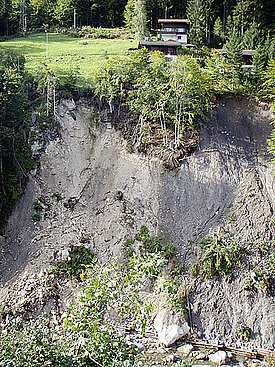
Stabilità del suolo ¶
In molte regioni la vegetazione fornisce un importante contributo alla protezione contro i pericoli naturali perché stabilizza il suolo. Il nostro istituto si occupa di studiare gli effetti esercitati dalle piante ospiti e dai loro funghi micorrizici sulla stabilità del suolo.
Il bosco protegge dai pericoli naturali: può impedire il distacco di valanghe, frenare le frane e stabilizzare i pendii ripidi. Non solo gli alberi, ma anche altre piante e pascoli proteggono da erosione e slittamenti. Con le loro radici stabilizzano il suolo, mentre con le parti aeree lo proteggono. I rami e le foglie assorbono l’impatto delle precipitazioni e schermano la superficie dal vento. In questo modo riducono la predisposizione del suolo all’erosione. Con le sue radici, la vegetazione non solo rafforza e consolida il suolo, ma gli sottrae anche l’acqua, riducendo ulteriormente il pericolo di sovrasaturazione e slittamenti. Per essere in grado di svolgere questi compiti, le piante devono crescere (cosa che riescono a fare solo con molta difficoltà nelle condizioni ostili tipiche dei terreni aridi o instabili).
La nostra ricerca mira a quantificare il contributo fornito dalla vegetazione in generale e dalle radici nello specifico alla stabilità del suolo e dei pendii. In particolare, siamo interessati anche alle funzioni e agli effetti dei funghi simbiotici (micorriza) presenti nelle piante utilizzate per garantire la stabilità del suolo. Affinché gli effetti stabilizzanti biologici confluiscano nel modo più completo e adeguato possibile nei calcoli della sicurezza e nelle analisi dei rischi, seguiamo un nuovo concetto di meccanica del suolo, che non considera solo i parametri della resistenza al taglio, ma anche le proprietà del materiale del suolo che, sotto l’effetto delle forze di taglio, può disgregarsi e aumentare il proprio volume.
